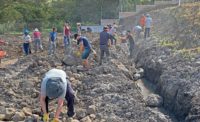Brinkman Construction recently completed work on the first phase of South Main Station, a multifamily and mixed-use project at First Avenue and Main Street in Longmont, Colo. The project is part of a larger plan for redeveloping the 26-acre former Butterball Turkey plant. The $70-million, mixed-use complex is the first large-scale urban apartment community built in downtown Longmont.
South Main Station has 253 apartment units and 10,000 sq ft of ground-floor space, including residential and commercial units that front Main Street. Of the five buildings, two include residential units built above street-level retail, and one building is a traditional walk-up with garden-level units. The Phase 1 mix includes 35 studios, 161 one-bedroom apartments and 57 two-bedroom units, averaging 860 sq ft. The complex also includes access to an onsite gym, yoga room and community room with a kitchen as well as a swimming pool, hot tub, firepits, pet spa, mail center and storage. One of the most unique amenities is a do-it-yourself garage with a self-service bike and ski workshop that’s open to all tenants.
The life sciences business unit at Merrick & Co. has been contracted to support Bolivia’s National Service of Agricultural Health and Food Safety (SENASAG) agency with master planning, civil, architectural, mechanical, electrical, plumbing and commissioning services for a future laboratory campus in Santa Cruz, Bolivia.
The campus will strengthen the country’s research and diagnosis capacity for veterinary, phytosanitary and food safety challenges. The new state-of-the-art facility will include five laboratory buildings for animal health, plant health, food safety, fruit fly research and administration.
The campus also will include space for future greenhouses, a sterile fly-egg production plant and a pesticide and fertilizer storage area. Merrick’s planning strategy has focused on designing modular spaces that can be installed within a metal frame structure and a perimeter curtain wall envelope with columns outside the laboratories. This approach meets SENASAG’s need for flexibility with future modifications and ensures quick construction—all while meeting international biosafety design standards.





